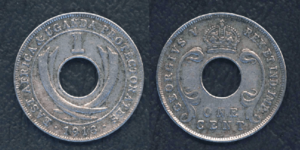East African rupee facts for kids
The rupee was a type of money used in parts of East Africa that were controlled by Britain between 1906 and 1920. These areas were called colonies and protectorates. Just like how a dollar is divided into 100 cents, the rupee was divided into 100 cents.
Before the East African Rupee, the Indian rupee was used in these areas. In 1920, the value of the rupee was changed compared to the British pound. One rupee became equal to two shillings, which was also called one florin. Soon after, the East African Rupee was replaced by the East African florin in the same year. Then, in 1921, the East African shilling took its place. One shilling was worth half a florin or half a rupee.
This currency is famous for having the world's very first aluminium coin! This special coin was a 1 cent coin made in 1907.
Coins of the East African Rupee
The first coins for the East African Rupee were made of silver. These were the 25 cent and 50 cent coins, introduced in 1906.
In 1907, a new 1 cent coin was made from aluminium. Also, a 10 cent coin made of cupro-nickel (a mix of copper and nickel) was introduced. The next year, in 1908, a very small 1⁄2 cent coin, also made of aluminium, was added.
By 1909, cupro-nickel replaced aluminium for making coins. Finally, in 1913, a 5 cent coin made of cupro-nickel was released.
Banknotes of the East African Rupee
Paper money, called banknotes, was also used. The government of the East Africa Protectorate started printing these notes in 1906, though the first ones were dated 1905.
These banknotes came in different values: 5, 10, 20, 40, 100, and 500 rupees. Just before the rupee was replaced, the East African Currency Board printed 1 rupee notes in 1920.


